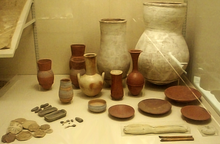EMBALMING
Embalming, in most modern cultures, is the art and science of temporarily preserving human remains (some may preserve for long-term) to forestall decomposition and to make them suitable for public display at a funeral. The three goals of embalming are thus sanitization, presentation and preservation (or restoration) of a corpse to achieve this effect. Embalming has a very long and cross-cultural history, with many cultures giving the embalming processes a greater religious meaning.
Embalming has been practiced in many cultures. In classical antiquity, perhaps the ancient culture that had developed embalming to the greatest extent was that of Egypt, which developed the process of mummification. The Ancient Egyptians believed that preservation of the mummy empowered the soul after death, the latter of which would return to the preserved corpse.
 Pottery, dishes and other miscellaneous items from the embalming cache of Tutankhamen.
The Inca and other cultures of Peru, carried out embalming rituals, as they lived in a climate which favored a form of mummification.
Pottery, dishes and other miscellaneous items from the embalming cache of Tutankhamen.
The Inca and other cultures of Peru, carried out embalming rituals, as they lived in a climate which favored a form of mummification.
Embalming has been practiced in many cultures. In classical antiquity, perhaps the ancient culture that had developed embalming to the greatest extent was that of Egypt, which developed the process of mummification. The Ancient Egyptians believed that preservation of the mummy empowered the soul after death, the latter of which would return to the preserved corpse.
 Pottery, dishes and other miscellaneous items from the embalming cache of Tutankhamen.
Pottery, dishes and other miscellaneous items from the embalming cache of Tutankhamen.


Comments
Post a Comment